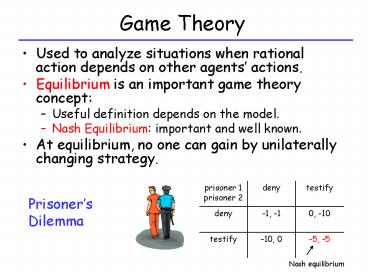Game Theory - PowerPoint PPT Presentation
1 / 9
Title:
Game Theory
Description:
... savings if k ' n. ... e-Nash, need t of the order poly(e,2-k) & running time ~ poly(n,1/e,2k) ... No guarantees for the running time. GRAPHICAL GAMES: A SURVEY ... – PowerPoint PPT presentation
Number of Views:43
Avg rating:3.0/5.0
Title: Game Theory
1
Game Theory
- Used to analyze situations when rational action
depends on other agents actions. - Equilibrium is an important game theory concept
- Useful definition depends on the model.
- Nash Equilibrium important and well known.
- At equilibrium, no one can gain by unilaterally
changing strategy.
Prisoners Dilemma
Nash equilibrium
2
Motivation for Graphical Games
- Tabular representation too large.
- n players, m actions n x mn entries
- Probability distributions also have huge tabular
representations. - Belief Networks attempt to capture locality of
interaction. - Instance of locality in games
- Payoff depends on at most 3 neighbors
- Tabular 10.310
- Locality 6.344.33
or
or
3
Graphical Games
Graphical model for the factory, shopping mall,
residential complex game
- If k-1 is an upper bound on neighborhood size
then mk entries. - Undirected graph corresponds to an assumption
about symmetry of interaction. - Can consider directed models too.
- Get exponential savings if k n.
4
Inference vs Equilibriums
- Exact P-complete
- Poly time exact algo for trees
- Basic message passing algo generalized in 2 ways
- Junction tree
- Loopy belief propagation
- Exact Open question (like factoring)
- Poly time exact algo for trees
- Similar generalizations attempted
- No real counterpart of junction tree
- NashProp
5
TreeNash algorithm
- Abstract algorithm Kearns et. al. two
realizations.
u1
u2
Upstream Pass
Downstream Pass
v
T(w,v)
w
- Message T(w,v) is a table with continuous
indices and is 1 iff given Ww, there is an
upstream Nash at V in which Vv. - Not clear how to implement.
- Two solutions
- discretize and obtain poly time algorithm.
- work with clever (but exponential)
representation of sets where T(w,v) is 1.
6
Two realizations
- Approximate
- Players play strategies that are multiples of t.
- T(w,v) is just a 1/t by 1/t matrix.
- To compute e-Nash, need t of the order
poly(e,2-k) running time poly(n,1/e,2k). - Exact
- T sets are always disjoint unions of axis
parallel rectangles. - of rectangles 2a3b (ainternal nodes,
bleaves) - Allows computation of every Nash equilibrium.
- Also have a polynomial time algo Littman at.
al. to compute exact equilibrium in trees but it
throws out potential equilibriums.
7
Function minimization and CSP
- Can handle general graphs.
- Define Regreti max amount which Pi can gain by
unilaterally changing strategy. - Computing Nash equilibrium is same as minimizing
sum of regrets. - Greedy hill climbing with random restarts
proposed in Vickrey Koller - e-Nash can be cast as a CSP.
- Constraint for player V says that projection of
global strategy to neighbors of V is restricted
to the set where Regreti e. - Discretize strategy space and use discrete CSP
techniques.
8
NashProp algorithm
- Two stage algorithm for general graphs Ortiz
Kearns - table passing stage
- assignment passing stage
- Table passing is in rounds tables provably
converge as we complete more rounds. - Search space for Nash equilibriums gets
(potentially) reduced. - Assignment passing phase is a backtracking search
through reduced search space. - No guarantees for the running time.
9
GRAPHICAL GAMES A SURVEY
Ambuj Tewari (ambuj_at_cs)CS281A Poster Session
- References
- Kearns et. al. Graphical models for game
theory, UAI 2001. - Littman et. al. An efficient exact algorithm
for solving tree-structured graphical games, NIPS
2002 - Ortiz Kearns Nash propagation for loopy
graphical games, to appear - Vickrey Koller Multi-agent algortihms for
solving graphical games, AAAI 2002































